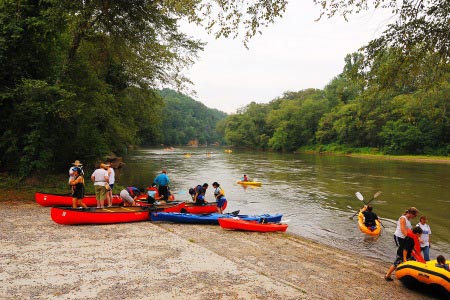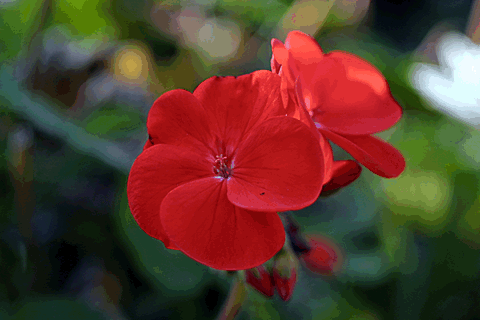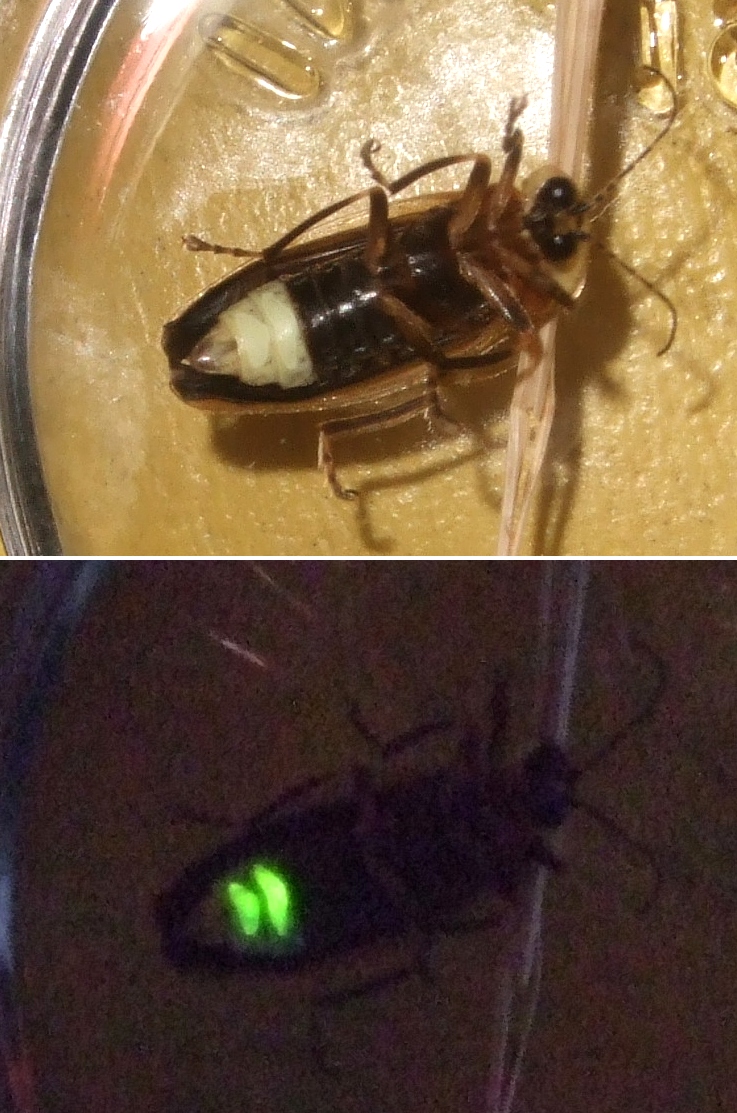|
Phausis Reticulata
''Phausis reticulata'', commonly referred to as the blue ghost, is a species of firefly found in the eastern and central United States. The species is common in the southern Appalachians, and can be seen in Great Smoky Mountains National Park, the Chattahoochee National Forest, as well as North Carolina's DuPont State Forest and Pisgah National Forest. Description The males of this all-brown species have a short second antennomere (compared to the third) as well as large eyes. Unlike many firefly species found in the eastern and central United States, ''P. reticulata'' males display a steady glow, instead of a species-specific flashing pattern. The light emitted by "blue ghost" fireflies appears to the human eye as blueish-white when observed at night from a distance, but bright green when examined at close range. This discrepancy in the observed color may be due to the Purkinje effect The Purkinje effect (; sometimes called the Purkinje shift, often incorrectly pronounced ) is ... [...More Info...] [...Related Items...] OR: [Wikipedia] [Google] [Baidu] |
Firefly
The Lampyridae are a family of elateroid beetles with more than 2,000 described species, many of which are light-emitting. They are soft-bodied beetles commonly called fireflies, lightning bugs, or glowworms for their conspicuous production of light, mainly during twilight, to attract mates. Light production in the Lampyridae is thought to have originated as an honest warning signal that the larvae were distasteful; this was co-opted in evolution as a mating signal in the adults. In a further development, female fireflies of the genus ''Photuris'' mimic the flash pattern of ''Photinus'' species to trap their males as prey. Fireflies are found in temperate and tropical climates. Many live in marshes or in wet, wooded areas where their larvae have abundant sources of food. While all known fireflies glow as larvae, only some species produce light in their adult stage, and the location of the light organ varies among species and between sexes of the same species. Fireflies ha ... [...More Info...] [...Related Items...] OR: [Wikipedia] [Google] [Baidu] |
Appalachians
The Appalachian Mountains, often called the Appalachians, (french: Appalaches), are a system of mountains in eastern to northeastern North America. The Appalachians first formed roughly 480 million years ago during the Ordovician Period. They once reached elevations similar to those of the Alps and the Rocky Mountains before experiencing natural erosion. The Appalachian chain is a barrier to east–west travel, as it forms a series of alternating ridgelines and valleys oriented in opposition to most highways and railroads running east–west. Definitions vary on the precise boundaries of the Appalachians. The United States Geological Survey (USGS) defines the ''Appalachian Highlands'' physiographic division as consisting of 13 provinces: the Atlantic Coast Uplands, Eastern Newfoundland Atlantic, Maritime Acadian Highlands, Maritime Plain, Notre Dame and Mégantic Mountains, Western Newfoundland Mountains, Piedmont, Blue Ridge, Valley and Ridge, St. Lawrence Valley, Appalac ... [...More Info...] [...Related Items...] OR: [Wikipedia] [Google] [Baidu] |
Great Smoky Mountains National Park
Great Smoky Mountains National Park is an American national park in the southeastern United States, with parts in North Carolina and Tennessee. The park straddles the ridgeline of the Great Smoky Mountains, part of the Blue Ridge Mountains, which are a division of the larger Appalachian Mountain chain. The park contains some of the highest mountains in eastern North America, including Clingmans Dome, Mount Guyot, and Mount Le Conte. The border between the two states runs northeast to southwest through the center of the park. The Appalachian Trail passes through the center of the park on its route from Georgia to Maine. With 14.1 million visitors in 2021, the Great Smoky Mountains National Park is the most visited national park in the United States. The park encompasses , making it one of the largest protected areas in the eastern United States. The main park entrances are located along U.S. Highway 441 (Newfound Gap Road) in the towns of Gatlinburg, Tennessee and Cherokee ... [...More Info...] [...Related Items...] OR: [Wikipedia] [Google] [Baidu] |
Chattahoochee National Forest
The Chattahoochee River forms the southern half of the Alabama and Georgia (U.S. state), Georgia border, as well as a portion of the Florida - Georgia border. It is a tributary of the Apalachicola River, a relatively short river formed by the confluence of the Chattahoochee and Flint River (Georgia), Flint rivers and emptying from Florida into Apalachicola Bay in the Gulf of Mexico. The Chattahoochee River is about long. The Chattahoochee, Flint, and Apalachicola rivers together make up the Apalachicola–Chattahoochee–Flint River Basin (ACF River Basin). The Chattahoochee makes up the largest part of the ACF's drainage basin. Course The River source, source of the Chattahoochee River is located in Jacks Gap at the southeastern foot of Jacks Knob, in the very southeastern corner of Union County, Georgia, Union County, in the southern Blue Ridge Mountains, a subrange of the Appalachian Mountains. The headwaters of the river flow south from ridges that form the Tennessee Valley ... [...More Info...] [...Related Items...] OR: [Wikipedia] [Google] [Baidu] |
DuPont State Forest
DuPont State Recreational Forest, commonly known as DuPont Forest, is a state forest, located in Henderson and Transylvania counties of North Carolina. The name originates from the fact that the DuPont company arranged the sale of the original tract to the state. Adjacent tracts have since been purchased and added to the state forest. Portions of the forest formerly contained a manufacturing facility for the production of X-ray film. The forest was used to shoot scenes from the 1992 film ''The Last of the Mohicans'' as well as the 2012 box office hit ''The Hunger Games''. On February 12, 2019, the forest added from Conserving Carolina, part of a section called the Continental Divide Tract that connects with other public lands. 314 more acres was added to the forest in 2019. History Before 1996, the area that is DuPont state forest today, Buck Forest, was owned by Dupont, who ran a plant on the property, until it was sold to Sterling Diagnostic Imaging. The remainder of the ... [...More Info...] [...Related Items...] OR: [Wikipedia] [Google] [Baidu] |
Pisgah National Forest
Pisgah National Forest is a National Forest in the Appalachian Mountains of western North Carolina. It is administered by the United States Forest Service, part of the United States Department of Agriculture. The Pisgah National Forest is completely contained within the state of North Carolina. The forest is managed together with the other three North Carolina National Forests (Croatan, Nantahala, and Uwharrie) from common headquarters in Asheville, North Carolina. There are local ranger district offices located in Pisgah Forest, Mars Hill, and Nebo. Name ''Pisgah'' (פִּסְגָּה) is a Biblical Hebrew word with several meanings: it can be used to describe someone’s best achievement; another meaning is the highest point of a mountain. Some translators of the Bible book of Deuteronomy translated the word as a name of a mountain in general, usually referring to Mount Nebo. Lastly, Pisgah also means “summit”. History The Pisgah National Forest was established in 19 ... [...More Info...] [...Related Items...] OR: [Wikipedia] [Google] [Baidu] |
Purkinje Effect
The Purkinje effect (; sometimes called the Purkinje shift, often incorrectly pronounced ) is the tendency for the peak luminance sensitivity of the eye to shift toward the blue end of the color spectrum at low illumination levels as part of dark adaptation. In consequence, reds will appear darker relative to other colors as light levels decrease. The effect is named after the Czech anatomist Jan Evangelista Purkyně. While the effect is often described from the perspective of the human eye, it is well established in a number of animals under the same name to describe the general shifting of spectral sensitivity due to pooling of rod and cone output signals as a part of dark/light adaptation. This effect introduces a difference in color contrast under different levels of illumination. For instance, in bright sunlight, geranium flowers appear bright red against the dull green of their leaves, or adjacent blue flowers, but in the same scene viewed at dusk, the contrast is rever ... [...More Info...] [...Related Items...] OR: [Wikipedia] [Google] [Baidu] |
Phausis Kentucky Dorsal Oblique
''Phausis'' is a genus of firefly beetles (family Lampyridae). These beetles are for the most part unimpressive in their appearance and behaviour, so have not drawn much study, and little is known about many of the species. Species in this genus are at least known from North America. Ten species are described in North America, ranging throughout much of the continent. The genera ''Phausis'' and '' Lamprohiza'' are very similar and in need of revision; the delimitations between the two are not clear. Alternatively, ''Phausis'' may be paraphyletic and/or at least in part synonymous with ''Lamprohiza''. The genus is traditionally placed in the tribe Photinini of the Lampyrinae, but at least the blue ghost firefly, ''Phausis reticulata'' does not seem to be particularly close to this group (or ''Lamprohiza'' for that matter) and might not even belong in the subfamily Lampyrinae. Description ''Phausis'' males are small compared to many fireflies, ranging from about . Most are b ... [...More Info...] [...Related Items...] OR: [Wikipedia] [Google] [Baidu] |
Phausis Kentucky Ventral
''Phausis'' is a genus of firefly beetles (family Lampyridae). These beetles are for the most part unimpressive in their appearance and behaviour, so have not drawn much study, and little is known about many of the species. Species in this genus are at least known from North America. Ten species are described in North America, ranging throughout much of the continent. The genera ''Phausis'' and '' Lamprohiza'' are very similar and in need of revision; the delimitations between the two are not clear. Alternatively, ''Phausis'' may be paraphyletic and/or at least in part synonymous with ''Lamprohiza''. The genus is traditionally placed in the tribe Photinini of the Lampyrinae, but at least the blue ghost firefly, ''Phausis reticulata'' does not seem to be particularly close to this group (or ''Lamprohiza'' for that matter) and might not even belong in the subfamily Lampyrinae. Description ''Phausis'' males are small compared to many fireflies, ranging from about . Most are b ... [...More Info...] [...Related Items...] OR: [Wikipedia] [Google] [Baidu] |
Lampyridae
The Lampyridae are a family (biology), family of Elateroidea, elateroid beetles with more than 2,000 described species, many of which are bioluminescence, light-emitting. They are soft-bodied beetles commonly called fireflies, lightning bugs, or glowworms for their conspicuous production of light, mainly crepuscular, during twilight, to attract mates. Light production in the Lampyridae is thought to have originated as an honest signal, honest Aposematism, warning signal that the larvae were distasteful; this was co-opted in evolution as a mating signal in the adults. In a further development, female fireflies of the genus ''Photuris'' mimic the flash pattern of ''Photinus (beetle), Photinus'' species to trap their males as prey. Fireflies are found in temperate and tropical climates. Many live in marshes or in wet, wooded areas where their larvae have abundant sources of food. While all known fireflies glow as larvae, only some species produce light in their adult stage, and ... [...More Info...] [...Related Items...] OR: [Wikipedia] [Google] [Baidu] |
Bioluminescent Insects
Bioluminescence is the production and emission of light by living organisms. It is a form of chemiluminescence. Bioluminescence occurs widely in marine vertebrates and invertebrates, as well as in some fungi, microorganisms including some bioluminescent bacteria, and terrestrial arthropods such as fireflies. In some animals, the light is bacteriogenic, produced by symbiotic bacteria such as those from the genus ''Vibrio''; in others, it is autogenic, produced by the animals themselves. In a general sense, the principal chemical reaction in bioluminescence involves a light-emitting molecule and an enzyme, generally called luciferin and luciferase, respectively. Because these are generic names, luciferins and luciferases are often distinguished by the species or group, e.g. firefly luciferin. In all characterized cases, the enzyme catalyzes the oxidation of the luciferin. In some species, the luciferase requires other cofactors, such as calcium or magnesium ions, and sometime ... [...More Info...] [...Related Items...] OR: [Wikipedia] [Google] [Baidu] |
Beetles Of North America
Beetles are insects that form the order Coleoptera (), in the superorder Endopterygota. Their front pair of wings are hardened into wing-cases, elytra, distinguishing them from most other insects. The Coleoptera, with about 400,000 described species, is the largest of all orders, constituting almost 40% of described insects and 25% of all known animal life-forms; new species are discovered frequently, with estimates suggesting that there are between 0.9 and 2.1 million total species. Found in almost every habitat except the sea and the polar regions, they interact with their ecosystems in several ways: beetles often feed on plants and fungi, break down animal and plant debris, and eat other invertebrates. Some species are serious agricultural pests, such as the Colorado potato beetle, while others such as Coccinellidae (ladybirds or ladybugs) eat aphids, scale insects, thrips, and other plant-sucking insects that damage crops. Beetles typically have a particularly hard e ... [...More Info...] [...Related Items...] OR: [Wikipedia] [Google] [Baidu] |





.jpg)



